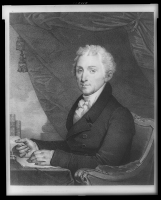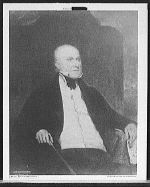
Monroe Doctrine

| Table of Contents | |
| Overview
Vocabulary Terms and Identifications |
Important
Maps
Biographies of Key Historical Figures |
|
|
|
The Monroe Doctrine was a document announced on December 2, 1823 that stated that the American continents were no longer open to colonization by European powers. It also became an important foreign policy for the United States. This document, as you may have already guessed, was written by the fifth president of the United States, James Monroe, with the help of John Quincy Adams. They wanted to speak their mind about helping Latin America financially. and that's exactly what they did. Later on, in 1904, the Roosevelt Corollary was added to the Monroe Doctrine. It was Theodore Roosevelt's ''amendment'' to the Monroe Doctrine. It said that to enforce the Monroe Doctrine, the United States will use military force.
The Monroe Doctrine played
a very important part in the history of the United States, because it told the European
countries that Latin America was no longer open to colonization and that the
U.S. was not going to help Europe colonize or have anything to do with colonization
any more.
Vocabulary and Identifications
1) President James Monroe - He was the fifth president who issued the Monroe Doctrine. He lived from 1785 - 1831, and was in office from 1817 - 1825.
2) Latin America - Land in Central America and South America where people speak Spanish. The early people that came there came directly from Spain. It also includes brazil, which was a Portuguese colony.
3) Monroe Doctrine - The document that stated that the United States didn’t want to colonize or have anything to do with colonizing Latin America. They were going to become independent nations, speak for themselves, and say their minds.
4) Democratic government - A democratic government is a republic where leaders are elected and no offices are obtained by birth or inheritance.
5) Monarchs - The kings and queens of Europe who wanted to
colonize the Western Hemisphere. They
didn’t support Latin America revolutions.
This map shows Latin America when it was controlled by European powers and
then when it became independent. The Monroe Doctrine closed this region of the
world off to European colonization and protected these nations as independent
countries.
Biographies
of Important People

James Monroe James Monroe was the fifth president. Monroe issued the statement speaking there minds to Spain, France, and Russia that they should leave Latin America alone. This message was issued in 1823. Monroe said that the Americas were closed to “Further colonization by any European Powers.” Monroe issued the Monroe Doctrine to state that America wasn’t going to colonize Latin America with the European countries. |
 John Quincy Adams John Quincy Adams was involved in the Monroe Doctrine. When the United States wanted to send the statement to Spain, France, and Russia Adams said “no,” the United States should speak for themselves and say their minds. Monroe agreed with Adams. Together the two wrote up the Monroe Doctrine stating that the United States did not want to colonize Latin America with the European Countries. |
Monroe Doctrine Quiz
Choose the correct answer
1. The Monroe Doctrine was written to__________?
A. For fill the American Dream B. Keep Europe
from colonizing Latin America
C. Make America industrial
D. Help Europe colonize Latin America
2. The Monroe Doctrine was written by James Monroe,
with the help of________?
A. John Quincy Adams B. Thomas Jefferson
C. George Washington D. John Hancock
3. James Monroe was the ________ president of the United
States?
A. 3rd B. 13th
C. 5th D. 23rd
4. Europe wanted to colonize _____ America?
A. South B. New
C. Latin D. North
5. The Monroe Doctrine became an important ______ policy
for the United States?
A. European B. unoriginal
C. foreign D. Doctrine
Match the correct letter with the definition
| ____6. The Monroe Doctrine is a _____?
____7. The Monroe Doctrine said that the
____8. The Monroe Doctrine became an
____10. A policy announced by President Monroe on Dec.12, 1823. |
A. Europe B. U.S.A. C. document D. Monroe Doctrine E. colonization |
Answers:
1. B
2. A
3. C
4. C
5. C
6. C
7. E
8. A
9. B
10. D
Resources:
Viola, Herman J., Why We Remember, Addison-Wesley Publishing Company, Menlo Park, California, 1998
Gilderhus, Mark T., Monroe Doctrine, World Book, Inc., Chicago, IL, 1998
Welling, George, A Hypertext on American History, [World Wide Web]. Available: http://odur.let.rug.nl/~usa/D/1801-1825/jmdoc.htm
This page is part of a web project developed by Mr. Cassutto's 7th grade US History class at Sterling Middle School
Student authors:
Michelle C.
Amanda H.
Caitlin M.
George Cassutto's Cyberlearning
World
[Lesson Plan of the Day] [Cassutto Memorial] [About the Author] [Search] [Civics Lesson Plans]